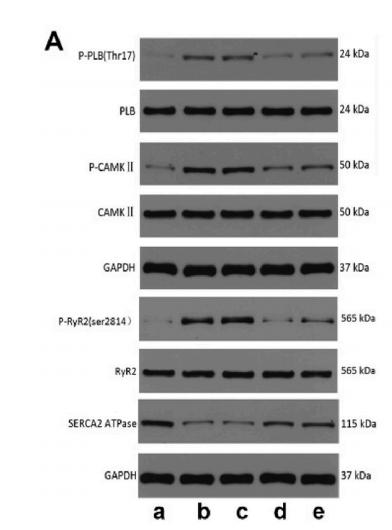Phospholamban Antibody - #AF7778
| Product: | Phospholamban Antibody |
| Catalog: | AF7778 |
| Description: | Rabbit polyclonal antibody to Phospholamban |
| Application: | WB IF/ICC |
| Cited expt.: | WB, IF/ICC |
| Reactivity: | Human, Mouse, Rat |
| Prediction: | Pig, Bovine, Horse, Sheep, Rabbit, Dog |
| Mol.Wt.: | 24kDa; 6kD(Calculated). |
| Uniprot: | P26678 |
| RRID: | AB_2844142 |
Product Info
*The optimal dilutions should be determined by the end user. For optimal experimental results, antibody reuse is not recommended.
*Tips:
WB: For western blot detection of denatured protein samples. IHC: For immunohistochemical detection of paraffin sections (IHC-p) or frozen sections (IHC-f) of tissue samples. IF/ICC: For immunofluorescence detection of cell samples. ELISA(peptide): For ELISA detection of antigenic peptide.
Cite Format: Affinity Biosciences Cat# AF7778, RRID:AB_2844142.
Fold/Unfold
Cardiac phospholamban; CMD1P; CMH18; PLB; Pln; PPLA_HUMAN;
Immunogens
A synthesized peptide derived from human Phospholamban, corresponding to a region within the internal amino acids.
- P26678 PPLA_HUMAN:
- Protein BLAST With
- NCBI/
- ExPASy/
- Uniprot
MEKVQYLTRSAIRRASTIEMPQQARQKLQNLFINFCLILICLLLICIIVMLL
Predictions
Score>80(red) has high confidence and is suggested to be used for WB detection. *The prediction model is mainly based on the alignment of immunogen sequences, the results are for reference only, not as the basis of quality assurance.
High(score>80) Medium(80>score>50) Low(score<50) No confidence
Research Backgrounds
Reversibly inhibits the activity of ATP2A2 in cardiac sarcoplasmic reticulum by decreasing the apparent affinity of the ATPase for Ca(2+). Modulates the contractility of the heart muscle in response to physiological stimuli via its effects on ATP2A2. Modulates calcium re-uptake during muscle relaxation and plays an important role in calcium homeostasis in the heart muscle. The degree of ATP2A2 inhibition depends on the oligomeric state of PLN. ATP2A2 inhibition is alleviated by PLN phosphorylation.
Phosphorylation by PKA abolishes the inhibition of ATP2A2-mediated calcium uptake. Phosphorylated at Thr-17 by CaMK2, and in response to beta-adrenergic stimulation. Phosphorylation by DMPK may stimulate sarcoplasmic reticulum calcium uptake in cardiomyocytes.
Palmitoylated by ZDHHC16, promoting formation of the homopentamer.
Endoplasmic reticulum membrane>Single-pass membrane protein. Sarcoplasmic reticulum membrane>Single-pass membrane protein. Mitochondrion membrane>Single-pass membrane protein. Membrane>Single-pass membrane protein.
Note: Colocalizes with HAX1 at the endoplasmic reticulum (PubMed:17241641). Colocalizes with DMPK a the sarcoplasmic reticulum (PubMed:15598648).
Heart muscle (at protein level).
Belongs to the phospholamban family.
Research Fields
· Environmental Information Processing > Signal transduction > Calcium signaling pathway. (View pathway)
· Environmental Information Processing > Signal transduction > cGMP-PKG signaling pathway. (View pathway)
· Environmental Information Processing > Signal transduction > cAMP signaling pathway. (View pathway)
· Human Diseases > Cardiovascular diseases > Dilated cardiomyopathy (DCM).
· Organismal Systems > Circulatory system > Adrenergic signaling in cardiomyocytes. (View pathway)
· Organismal Systems > Endocrine system > Thyroid hormone signaling pathway. (View pathway)
References
Application: WB Species: rat Sample: Heart
Application: IF/ICC Species: Rat Sample: H9C2 cardiomyocytes
Application: WB Species: Rat Sample: H9C2 cardiomyocytes
Restrictive clause
Affinity Biosciences tests all products strictly. Citations are provided as a resource for additional applications that have not been validated by Affinity Biosciences. Please choose the appropriate format for each application and consult Materials and Methods sections for additional details about the use of any product in these publications.
For Research Use Only.
Not for use in diagnostic or therapeutic procedures. Not for resale. Not for distribution without written consent. Affinity Biosciences will not be held responsible for patent infringement or other violations that may occur with the use of our products. Affinity Biosciences, Affinity Biosciences Logo and all other trademarks are the property of Affinity Biosciences LTD.




